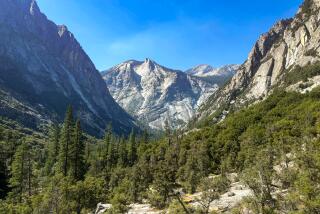California’s accessible campsites put the outdoors within reach
- Share via
When Steve Dalton sets up at Yosemite’s Housekeeping Camp, a popular campground along the Merced River with views of Half Dome and Yosemite Falls, it takes him back to childhood camping trips with his parents and a time before his spinal cord injury.
“I love getting outdoors and I think, following my disability, adaptive sports and things that drew me back outside were the things that were most restorative for me as a person,” said Dalton, 51, an information technology systems administrator who is paralyzed from the chest down since a motorcycle accident in 2002.
Dalton and his wife, Sydney Sauber, an educator, head out into nature several times a year from their home in San Pablo, Calif.
“It’s an opportunity to challenge myself,’’ he said, “and create situations where you have to problem-solve, you have to test the skills that you have as a [wheel]chair user to deal with terrain that’s not well-groomed.”
If you crave that kind of challenge, or just want a getaway, California’s vast state parks system offers many accessible camping options. If this is in your summer plans, however, you need to reserve now.
Traveling with someone with Alzheimer’s is doable. The key is to prepare »
Here’s a quick guide to finding an accessible campsite and planning for the great outdoors.
Choose your site
California State Parks operates more than 80 campgrounds with at least one site that can accommodate persons with disabilities.
This means that visitors with mobility, vision and hearing disabilities can access lodging options, pathways, restrooms, visitor centers or other campground features.
At the parks department website, you can sort these parks alphabetically or by region.
Each park has a web page that describes its accessible features.
At the Malibu Creek State Park site, for example, you’ll find that there are four accessible campsites, but the restrooms are described as “generally accessible.”
That means the bathrooms meet many current building codes, but some visitors may require assistance. Good to know. For more information, call the park and ask a ranger for specifics.
In Northern California, Bothe-Napa Valley State Park has three campsites, four rustic yurts and two cabins that have been renovated to accommodate visitors who use mobility devices. Campsites have fire rings and picnic tables.
New rule requires airlines to report mishandling of mobility equipment »
Bonus: For $1, you can book an accessible shuttle into nearby Calistoga or St. Helena for wine tasting.
Another important source of information I rely on: reviews by people with disabilities who have first-hand knowledge.
Greg Rushall, a retired mechanic from El Cajon who lives with muscular dystrophy, bought a trailer in 2006 and has camped at many sites through San Diego County. Santee Lakes Recreation Reserve is one of his favorites.
“We try to go [camping] once a month to disconnect and reconnect with nature,” said Rushall, 64. He chooses sites that have paved pathways so he doesn’t track dirt inside his camper and selects hiking trails that match his abilities.
How to camp
There are many ways to camp: a traditional tent, high-end glamping or something in between.
“It’s a good idea to distinguish between camping and the degree to which you can enjoy the park,’’ said Sauber, Dalton’s wife. “Being in a cabin, being in a yurt and being in a tent are all different experiences.”
Novice campers should consider their level of physical function — for example, the ability to set up a tent or do floor-to-wheelchair transfers — then determine what they want to expend energy on.
Example: If transferring to the floor is difficult, book a cabin or yurt that has a bed or a cot.
“The kind of equipment you use and level of mobility or degree to which you have folks willing and able to help you also sort of dictates what the best choices might be for you,’’ Dalton said.
Ways to adapt
Along with everything you would typically pack for a camping trip, consider what else you might need, access-wise.
Rushall takes polio crutches or walking sticks for hikes, knee pads for when he has to hook up a hitch to his truck, and stair steps that attach to his camper.
“With the steps to the trailer I try to make it simple and easy for me to get up and down,” he said.
He removes debris from his campsite that might post a tripping hazard and makes sure to have a box or bucket nearby to help him get up if he’s had to get down on the ground.
It’s also important to prepare for the terrain. Paths may appear traversable, but nature being nature, you never know what rock or tree root awaits around the bend.
Dalton switches out his wheelchair’s street tires for knobby ones and carries a small toolkit for quick repairs on his manual wheelchair. Clip-on flashlights help him avoid roots, rocks and ruts in the dark.
“With camping, you have to be willing to welcome the unexpected,’’ Dalton said. “Know you are going to have to make adjustments as you go along, but the reward ends up being worth any of the hassle.”
BOX
►Don’t leave availability to chance. Reserve your accessible California State Park camping spot online.
►For $3.50, you also can buy a lifetime disabled discount pass to California State Parks.
►Access Northern California offers well-researched reviews of accessible campsites as well as a list of adapted outdoor recreation equipment, including raised tent cots.
More to Read
Sign up for The Wild
We’ll help you find the best places to hike, bike and run, as well as the perfect silent spots for meditation and yoga.
You may occasionally receive promotional content from the Los Angeles Times.






